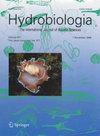墨西哥韦拉克鲁斯珊瑚礁系统国家公园(PNSAV)影响区域内海滩上的微塑料
IF 0.3
4区 生物学
Q4 MARINE & FRESHWATER BIOLOGY
引用次数: 1
摘要
背景。在过去的几十年里,塑料产量大幅增加,2019年的产量为3.68亿吨,其中相当一部分被丢弃到环境中,在那里它们磨损并分解成微塑料。目标。对国家韦拉克鲁萨诺公园(PNSAV)影响区域的海滩上的微塑料进行量化和表征。方法。本研究取样了韦拉克鲁斯海岸的沙滩,更具体地说,分别在拉曼查、查卡拉卡斯、查尔奇韦坎、Antón利扎尔多和埃尔森德罗,分别在Actopan、Úrsulo Galván、拉安提瓜和阿尔瓦拉多市。通过干燥、筛分得到塑料颗粒,并用FTIR和SEM对其进行定量和表征。结果。在PNSAV影响区共发现180个塑料碎片(4.5个/m2)。El Sendero和Chachalacas的海滩上出现的塑料碎片最多。在体系中颗粒总数中,92.35%为不规则形状,其余为纤维、颗粒和薄膜。关于海滩上发现的塑料聚合物的类型和主导地位,三种主要材料是高密度聚乙烯和低密度聚乙烯(分别为26.67%和27.22%)和聚丙烯(23.33%)。结论。在所有被分析的海滩上都发现了微塑料,其中大多数形状不规则,对摄入它们的生物来说是一种风险,因为它们是致病微生物的载体和有毒化学物质的传播者。本文章由计算机程序翻译,如有差异,请以英文原文为准。
Microplastics in beaches within the influence area of the Veracruz Reef System National Park (PNSAV), Mexico
Background. Plastic production has increased considerably in the last decades, with production during 2019 of 368 million tons, where a considerable amount is discarded into the environment, where it wears out and decomposes into microplastics. Objectives. Quantify and characterize the microplastics on the beaches of the area of influence of the Parque Nacional Sistema Arrecifal Veracruzano (PNSAV). Methods. The present study sampled sand beaches on the coasts of Veracruz, more specifically in La Mancha, Chachalacas, Chalchihuecan, Antón Lizardo, and El Sendero, in the municipalities of Actopan, Úrsulo Galván, La Antigua and Alvarado, respectively. Plastic particles were obtained after drying and sieving the sand and were quantified and characterized by spectroscopy (FTIR) and electron microscopy (SEM). Results. A total of 180 plastic pieces (4.5 pieces /m2 ) were found in the zone of influence of the PNSAV. El Sendero and Chachalacas’s beaches presented the most plastic pieces. Of the total number of particles in the system, 92.35% were irregularly shaped, and the rest were fibers, pellets, and films. Regarding the type and dominance of plastic polymers found on the beaches, the three primary materials were high and low-density polyethylene (26.67 and 27.22 %, respectively) and polypropylene (23.33 %). Conclusions. Microplastics were found on all the beaches analyzed, most of which were irregular in shape, representing a risk for organisms that ingest them since they serve as vectors of pathogenic microorganisms and dispersers of toxic chemicals.
求助全文
通过发布文献求助,成功后即可免费获取论文全文。
去求助
来源期刊

Hidrobiologica
生物-海洋与淡水生物学
CiteScore
0.40
自引率
0.00%
发文量
8
审稿时长
>12 weeks
期刊介绍:
HIDROBIOLÓGICA es una publicación cuatrimestral que difunde trabajos originales e inéditos de investigación o revisión, sobre temas relacionados con los organismos y la hidrología de los ambientes acuáticos, dulces y marinos y va dirigida a investigadores de todo el mundo, interesados en las diversas disciplinas que incluye la Hidrobiología , así como a alumnos de posgrados y licenciaturas relacionados con la biología, ecología, taxonomía, filogenia y evolución de organismos acuáticos, e hidrología y oceanografía de ambientes s dulceacuícolas y marinos.
 求助内容:
求助内容: 应助结果提醒方式:
应助结果提醒方式:


